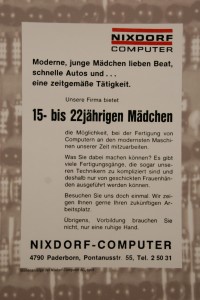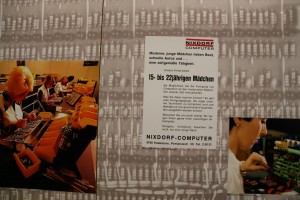Last year I took a group of students on a field trip to the Nixdorf computer museum in Paderborn, Germany. Just by accident my eyes were drawn to the poster you can see next to this post. It didn’t have an explanatory text, just a caption saying “job opening of the Nixdorf-Computer from 1968.“ So, what does the poster say?
Modern, young girls love beat music, fast cars and … a timely occupation.
Our company offers 15 to 22 year-old girls
the possibility to participate in the manufacturing of computers, the most advanced machines of our time.How can you contribute? There are many parts of the manufacturing process that are even too complicated for our technicians [male] and hence can only be executed by skillful woman’s hands.
Drop by and visit us! We will gladly show you your future workplace.
By the way, no formal training is required — only calm hands.
I was puzzled by this poster. While it told me a familiar story about gender difference, it also complicated my views on 1960s gender stereotypes. There is the expected sexism, for example, addressing future workers as girls [Mädchen] instead of women [Frauen] and reducing female bodies to skillful hands. However, the ad also appeals to the technological interest of the reader by evoking a narrative of progress, frontier spirit and adventure. In addition, it claims that some parts of the work process are too complicated for the male technicans. Even today German women are usually constructed as lacking interest and skill in technology. Hence, this poster was a surprise to me.
Of course, the world of computer manufacturing wasn’t as glamorous as it is promised here. These jobs usually had no opportunity for advancement, were paid badly and did not offer the security of a long-time employment.
Yet, I am wondering, who is driving the “fast cars” that the “girls” are supposed to be obsessed with? I doubt anyone who worked on this job could afford a car back in those days. Apart from that, in 1965 only 1/5 of the women had a driver’s license in Germany.


I think the 1950s and 60s were really interesting for exactly this contradictory set of trends you identify. In the initial decades after WW II it was not that easy to put women back in the private sphere, after the exhortations to participate in the war effort (of course this particular rhetoric varies by nation…) It was not until the ’80s that things began to be “purified” again into the simpler gender norms that we tend now to associate with technology and gender. Here is historian Londa Schiebinger’s interesting (somewhat related) comment, in “Has Feminism Changed Science”:
“The Federal Republic of Germany has the distinction of being one of the worst possible places for academic women … At the elite Max Planck Institutes in 1997, only 2 % of the scientific members wer women. This contrasts with the former German Democratic Repiblic, where women held a significantly higher proportion of academic positions overall and constituted 9% of all physicists. These numbers have dropped dramatically since reunification…” (Schiebinger 1999, p 39)